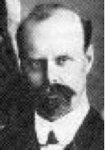Then along came AJ
 I stumbled upon a good case study of denominational turnaround while researching for a report on the Baptist Union of Australia.
I stumbled upon a good case study of denominational turnaround while researching for a report on the Baptist Union of Australia.
Around the turn of the century the Baptist Union in the state of NSW was languishing. Almost seventy years of ministry had resulted in just 37 churches in the most populous Australian colony. Only Tasmania had fewer Baptists.
Then along came AJ Waldock to turn things around. This is what he taught me:
1. Appoint visionary leadership
In 1904 the Union appointed a young man to lead Home Missions—AJ Waldock.
Previously Home Mission Secretaries were just that—secretaries or administrators. Waldock reinvented the role and began travelling to every corner of the state.
By the end of his first year 9 mission stations became 13. The number of preaching stations had doubled to 40. The number of workers in the field grew to 22.
2. Commit to an effective strategy
Waldock was not just an energetic activist. He was a strategist. He produced a strategy paper for the 1905 Assembly: “Methods of Home Mission Work”. His approach was direct and uncompromising.
“All too long has our denominational expansion been left to haphazard and chance. We need a fixed policy and a determined plan; we need a method in our work that will give some guarantee of a going forward all the time.”
‘Too long the [Home Mission] Committee has been the benevolent institution of the denomination—the asylum of aged and infirm Churches—a kind of ecclesiastical couch for sleeping congregations to repose their weary limbs—a perambulator for carrying infant causes which never learn to walk’. AJ Waldock
3. Stay on target
Waldock argued that the primary role of the Society was not to prop up struggling churches that could not fend for themselves. It must be to establish new churches that grow to healthy independence and then reproduce.
Waldock laid down a number of practical steps towards this goal:
- Overcome the tyranny of distance by grouping churches into District Associations, under the leadership of a senior minister. Each Association was to take responsibility for Mission in their region.
- Appoint a salaried General Superintendent of Home Missions.
- Reorganize finances so that mission workers could be paid and directed centrally.
The primary purpose of the Society must be church planting and evangelism. Struggling churches would only be supported if funds permitted.
The Annual Assembly of 1905 adopted Waldock’s vision for expansion. A young and inexperienced minister of 32 years had struck the first blow in the battle to turn the denomination around.
4. Partner with key leaders and churches
CJ Tinsley was the other key figure in the resurgence of the BUNSW. Australian born, he trained at Spurgeon’s College London. He returned to take up leadership at the newly constituted Stanmore Baptist in 1901.
For the next thirty years Tinsley was “a blaze of evangelistic fire and fervour” at Stanmore and among the Baptist churches throughout the state and nation. He was a great evangelist and he led the whole denomination into evangelism.
In 1912 he became President of the Union. The denomination was already advancing under Waldock’s leadership in the field. Tinsley challenged them to go further.
“We must preach or we will perish; we must evangelise or we shall fossilise; we must be a missionary force or we shall become a missionary field.”
5. Partner with major donors
Right from the beginning Waldock’s vision for expansion was supported by a small group of major donors led by Hugh Dixson and William Buckingham. By 1925 Dixson had contributed £11,000, Buckingham, £3,000.
The outcome?
From 1901-1930 the number of churches and members in NSW almost tripled.

